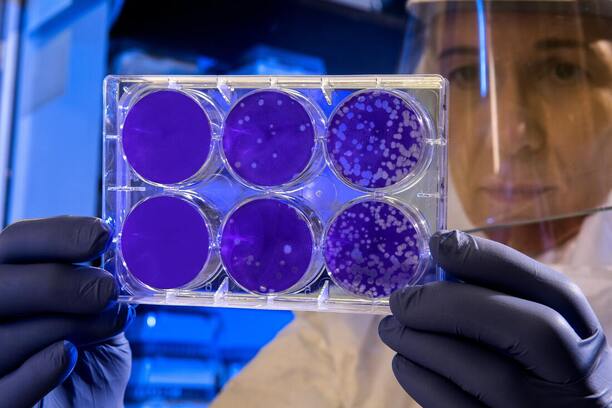H.B.2 Cells As A System
|
Click here to view and print the outline for this unit of study.
|

Photo by CDC on Unsplash
Woman holding laboratory appratus
Scientist examines the result of a plaque assay, which is a test that allows scientists to count how many flu virus particles (virions) are in a mixture. To perform the test, scientists must first grow host cells that attach to the bottom of the plate, and then add viruses to each well so that the attached cells may be infected. After staining the uninfected cells purple, the scientist can count the clear spots on the plate, each representing a single virus particle.
|
|
H.B.2A.1 Biological Molecules
|
1. What type of chemical molecules make up sugar, flour, and oil?
2. What similarities and differences exist between the molecules that make up sugar, flour and oil? Study the graph. 3. What does kJ stand for? What does it mean? 4. How many years are represented by this graph? 5. Based on the graph, which macronutrient has always been the primary source of energy? 6. Has the ratio of micronutrients changed since 1960? Explain. 7. Compare: How many kJ of carbohydrates, fat, and protein did the average person consume in 1970? 1980? 2000? 8. How to carbohydrates, fats and proteins store energy? Which group of molecules' energy is preferred by cells? 9. Explain the heading "Empty Calories." 10. What kinds of foods offer us empty calories? |
H.B.2A.2 Enzyme Activity
|
-A student was making Jello and saw this Note on the side of the box.
-The student noted the words "fresh or frozen," and wondered why these fruits would prevent Jello from setting. -The student did some research then decided to do an experiment. -Use the prompts below to prepare a lab report in your notebook. |
|
Question: Will Fresh and Cooked Pineapple Both Prevent Jello from Setting?
Hypothesis: Based on the statement on the Jello box, what you know about enzymes, and your research - what do you think will be the answer to the title question? Materials: Read the procedure. Use this to list the materials needed for the experiment. Procedures: In your notebook, sketch this experimental design. Label the items you draw. (Hint) |
|
Preparation:
A. Measure 20mL of water in a graduated cylinder, pour into a plastic cup. Use a pen to mark the water level. Empty the water into the sink. Repeat for each of 4 plastic cups. B. Label your cups. #1: Gelatin only #2: Fresh pineapple #3: Frozen pineapple #4: Cooked pineapple C. Obtain 1 piece of pineapple (the same size) for cups #2, #3, and #4. Pat all pieces dry, except 1 piece of fresh pineapple that will need to be cooked. Using a scale can help you to measure all the same size pieces. D. Cooked pineapple: Place 1 piece of fresh pineapple into a clean dry test tube. Cover the tube with plastic. Using a test tube holder, set the test tube into a hot water bath, for 6 minutes (watch the clock). Once cooked, dump the pineapple onto a sheet of paper towel to cool. Pat the pineapple dry. Experiment: 1. Measure 50mL of cold water (no ice) in a graduated cylinder. Pour into a glass beaker. 2. Add 1 packed of unflavored gelatin. Stir well. Allow to sit for 60sec. 3. Measure 50mL of hot water in a graduated cylinder. Add to the beaker. Stir well. 4. Pour gelatin mixture into each cup, up to the line you drew in preparatory step A. Be sure you have emptied the water from the cup before adding gelatin. 5. Add the correct piece of pineapple to each cup—see the labels you wrote in preparatory step B. 6. Observe your cups as you allow the gelatin to set/congeal. |
Data: Use a ruler to design a data chart for this experiment.
Supposed Results & Conclusions: You may actually do this experiment, but if time does not permit, please watch this video. It's not the same experiment, but it's closely related. Do some research to help you understand why Jello will not set with fresh pineapple and why it (may) set with cooked pineapple? What enzyme(s) does pineapple contain and what process does it interrupt within jello?
Supposed Results & Conclusions: You may actually do this experiment, but if time does not permit, please watch this video. It's not the same experiment, but it's closely related. Do some research to help you understand why Jello will not set with fresh pineapple and why it (may) set with cooked pineapple? What enzyme(s) does pineapple contain and what process does it interrupt within jello?





